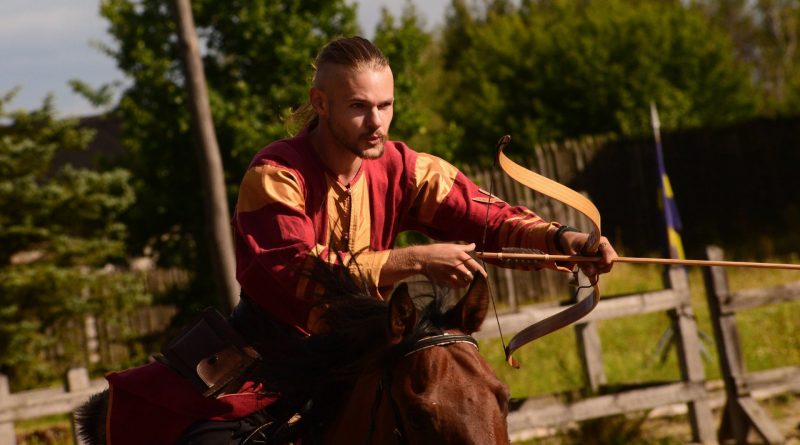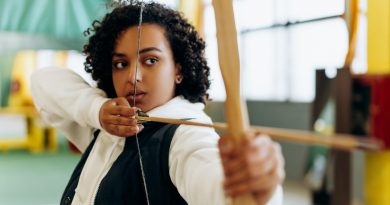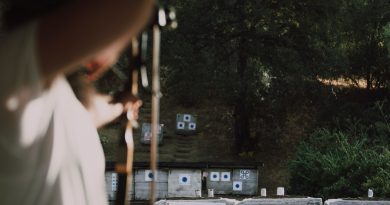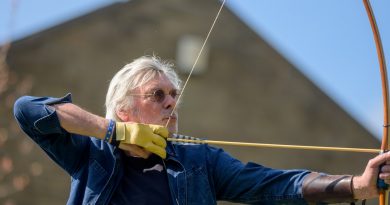The Bow – Types, Materials, and Characteristics
The bow can truthfully be said to have been man’s universal weapon, down through the ages. With it he procured food for himself and his family and defended himself from his enemies. Australia is the only large land mass where the bow was unknown to the aborigines. The Bush man of Australia is at the bottom of the scale of civilized man; and it is interesting to note in reading history, that from ancient times to the advent of firearms, the nations who reached the highest degree of civilization also excelled in the use of the bow as a military weapon.
Lacking modern means of communication and transportation, the ancients were unable to exchange either commodities or ideas, and although the bow was almost universally known, it was constructed by necessity of materials indigenous to a locality and readily available to the inhabitants. Thus from the high steppes of Asia and the Far East where timber was scarce and almost non-existent over large areas, came the earliest counterpart of the modern composite bow. Fabricated from horn, wood, and sinew, it was used by the armies of Assyria, by the Mongols, the Chinese, and the Turks.
The wooden long bow of Western Europe was probably introduced into England from the Scandinavian countries, and underwent little change or improvement until the present century. Discarded by the English speaking peoples as a military weapon, it was relegated to a minor role in sport and no sincere effort was made to improve its performance.
The efficient modern bow has evolved through scientific research in many fields of material, and its characteristics and the application of the findings have been utilized to improve performance. For discussion purposes, bows may be divided primarily into three groups: the wood self bow of which the English long bow is the prototype; the composite bow, a bow constructed of several different materials; and the all-metal bow, and the fibre-glass bow, the most recent developments of the bowyer’s art.
At first, efforts to improve the cast of the self bow, without at the same time increasing the drawing weight proportionally, were confined to the search for a suitable wood that would produce the desired results when processed into a bow. Little or no attempt to change the cross section of the bow was made at this time. The principal bow woods are: yew, osage orange, lemonwood, and hickory. Lancewood, a straight grained, tough, elastic wood of the family annonaceac obtained from the West Indies and Guiana was at one time a favorite bow wood of the English bowyers, but is little used today. Lemonwood is imported from Cuba. It receives its name from its color to distinguish it from lancewood. It is a very reasonably priced bow wood and makes an efficient, serviceable, and nice appearing bow. Machine tools can be used in manufacturing a bow from lemonwood and this accounts in part for the low price of the finished article. Yew is rated as the preferred bow wood, with osage orange second. Yew is a softer wood than osage orange, and a bow constructed of yew is considered to have a smoother cast than one made from osage orange. For this reason it is the preferred bow wood of many target archers. Osage orange is more durable than yew and is very fast in action. It can be called the universal bow wood, as it is suitable for the construction of both target and hunting bows of all kinds. Yew and osage orange bows are made almost entirely by hand, and this accounts, in part, for the high cost of this type of bow. Hickory makes a very durable bow, but it rates lowest in cast of the bow woods. However, when carefully made of selected and well seasoned stock it is a good low priced bow.
Having exhausted the possibilities of the different species of wood to increase the performance of the self bow, a craftsman began experimenting with changes in design of the conventional English long bow. Gradually the best features of the long bow and the short flat bow of the American Indian were combined to produce the modified flat bow,
Let us digress for a moment and examine the physical changes which take place in the fibres of the bow when it is flexed or drawn, and study the resultant internal stresses that are set up in the bow. These internal stresses or forces are what gives the bow its casting power. Wood has the property of elasticity. Within certain limits, when an external force is applied, it can be elongated or compressed; and when the external force is removed the wood fibres, which have been subjected either to tension or compression, will return to their original shape.
The wood fibres of a bow may be ruptured in two ways: elongation of the fibres beyond their elastic limit, which results when a bow is overdrawn. This will inevitably result in a broken bow if done repeatedly, and it can occur the first time that a bow is overdrawn. Repeated flexing, or drawing and shooting the bow, will finally weaken the fibres until they begin to break down. The fibres will stand only so many distortions before they may be said to have worn out. The same physical laws apply to bows made of metal or any other material. For this reason the life of every bow is limited.
The bowyer’s aim is to achieve a nice balance between the forces of tension in the back of the bow and the forces of compression in the belly. Working together, these forces give the bow its cast, or propelling power.
Since the compressive strength of wood is much greater per unit of area than its tensile strength, excess wood was gradually removed from the belly of the bow to achieve a balance of the two forces. In this manner the modified flat bow evolved.
Self bows of the modified flat type are popular among archers, and the same basic design has been used in the manufacture of laminated bows. Self bows of the modified flat type are durable, smooth in action, and have an excellent cast.
In the increasing and unceasing effort to develop better bows, archers with scientific training have made use of their knowledge of stresses in materials, and have improved the modified flat type bow by recurving the ends of the bow limbs,
The research chemists of the past decade have provided the modern bowman with backing far superior to the rawhide and sinew which had been the only materials widely used. Since we know that the fibres in the back of the bow are under tension in the draw, it follows that material selected for backing should have a high tensile strength and elasticity, so that it will be slow to yield to fatigue through repeated elongation and contraction of the fibres. The physical properties of the material should be such that the material is impervious to changes in temperature and weather. Certain of the cellulose compounds and fibre glass products, marketed under different trade names, meet these requirements. When a strip of one of these materials is cemented to the back of the bow, the inherent power of the fibres, elongated by the draw, to return to their original position adds appreciably to the cast of the bow.
In the background we should always remember that the bowyer is searching for ways to improve the cast of the bow without a proportional increase in the amount of force required to bring the bow to full draw. It is not difficult to build a self bow with an increased cross section that will have an improved cast. Unfortunately, if this is all that is done, the drawing weight will have increased proportionally.
The next logical step in bow design was to build a laminated bow taking advantage of the knowledge of the internal stresses in different materials, which vary in amount when the same external force is applied. A typical modern bow of this type has a fibre glass backing, a wooden core, and a fibre glass belly. In the draw, the fibre glass on the back elongates and that on the belly compresses or contracts. The internal stress built up in these materials during the draw is taking full advantage of the high tensile strength and elastic properties of the fibre glass on the back of the bow, and its compressive strength and inherent ability to return to its original shape when the external force is released. The high compressive strength of the fibre glass used on the belly of the bow permits a reduction of the cross sectional area from that required in a wood self bow. In consequence we find that the cross section of the laminated bow has assumed a rectangular shape with slightly rounded ends,
The principal difficulty encountered by the manufacturers of the laminated bows has been to develop a glue which will perform satisfactorily when it is used to bind together two materials whose properties of elasticity are not equal. Certain combinations of materials which made a laminated bow of excellent shooting qualifications could not be used because their properties of elongation were at such variances that failure occurred in the glued joint. Until a glue is developed that has, in addition to its cohesive properties, the additional property of enlongating under stress, it is necessary to limit the materials used in building laminated bows to those materials that have relatively similar characteristics or properties of elongation. To gain additional propelling power by the continued application of force over a greater distance than had been possible using a self bow, advantage has been taken of the greater elastic properties of the materials used in the face and belly of the laminated bows. The bow has been constructed so that it is reflexed when unbraced,
The author has been privileged to shoot several of these laminated bows over a period of several years. They have a smooth action and beautiful casting power. With an under-jaw anchor and using a bow sight, the author had a sight on the gold at 100 yards with a laminated bow which had a drawing weight of only 34 J4 pounds.
The Metal Bow
The elastic properties of metal are well known and the resilience of a metal bar under stress is the work done, upon the bar, in producing that stress, or in theory, the work the bar will do in regaining its original shape when the external force which has produced the stress is removed. These two properties of a metal are used to advantage in many articles in common use. The automobile spring and the main spring in your watch are examples. The processing of steel is so controlled that the strength of various properties of the metal can be varied to conform to the use which is to be made of the finished product. The terms: “hard” and “mild” steel are in common use.
Under stress up to its elastic limit (graph If we continue to stress the metal, it will again resist the application of continued increase in increments of stress, but the corresponding stretch will be greater, until the ultimate strength of the metal is reached at the point designated
C on the graph. Any increase of stress will now cause the bar to rupture at the point designated D on the graph. This abbreviated course in Strength of Materials will permit a better understanding of physical properties of a recent addition to bow materials, in the appearance on the market of the metal bow. Certain steels and aluminum alloys have been used extensively in recent years in the manufacture of metal bows and arrows.
Working within the elastic limit of the material; that is between the points O and A on the graph, the life of a metal bow in theory, would be limited only by the phenomenon known as the “fatigue” of the metal. The molecular structure of metal, under repeated distortions within the elastic limit, will finally crystalize and break down. This is a slow but inevitable process. The exposed cross section of a metal bow which breaks under these circumstances has the appearance under a microscope of a granular structure somewhat similar to cast iron.
The sum of the maximum tension and maximum compression stresses in a bow which is subjected alternately to tension and compression is called the range of stress in the bow. For a given number of applications of the stress, the load required for rupture is least when the range of the stress is greatest. When, as in a bow, the stress is alternately tension and compression, rupture takes place more readily than if it is always tension or always compression. That is, it takes place with a less range of stresses applied a given number of times, or with a less number of applications of a given range of stress. For a given number of applications of stress, the most unfavorable condition is where the tension and the compression are equal. Rest between stresses increases the resisting power of a piece of material, which is the reason that the bow should always be unbraced when not in use, and the fistmele checked occasionally when used for long periods of time. The main spring in your watch finally breaks due to the fatigue of metal, not because it has any more or less work to do at a given time. This slow deterioration is progressive and can account for the spring in the old car breaking down when you hit one bump too many, although not necessarily a hard one. Theoretically, a metal bow should let down at the yield point rather than break when the bow is drawn beyond its elastic limit. So much for theory. In practice no two melds of steel can be exactly alike nor can the finished product be guaranteed free of imperfections. A bow may rupture from a fault in the metal. So, although widely acclaimed by the manufacturers, metal bows have their limitations just as bows made of other materials.Metal bows generally are light in weight. They have an excellent cast and consequently a flat trajectory which can generally be said to exceed that of a wooden self bow with the same drawing weight. A flat trajectory is a decided asset in wooded areas when hunting game. The game may be in plain sight, but frequently the vertical clearance in the line of flight is insufficient to deliver an arrow to the mark. This is one of the reasons a good case can be made for the heavy drawing weight of a hunting bow. Bowmen are divided in their opinions as to whether the metal bows are as smooth shooting as some of the laminated and self wooden bows.
Some metal bows can be taken apart at the handle, which reduces the problem of transportation. One model known to the author has an adjustable lower limb. Limbs are replaceable on the metal bows, although it is the personal feeling of the author that replacing one of the limbs of a metal bow would give results about equal to the old practice of replacing a single broken leaf in an automobile spring, now long discontinued.
The Center Shot Bow
Since the arrow passes on the left side of the bow, and the string returns to the middle, it would appear that the arrow should fly far to the left. Actually well made arrows are spined for a particular drawing weight of bow. By spine we mean the quality of stiffness and resiliency of an arrow. Properly spined, an arrow actually bends around the bow in flight, and oscillates as it flies toward the target. During this change of direction the arrow loses some of its initial velocity. Dr. Clarence N. Hickman propounded the proposition that the arrow should be shot from a point nearer or at the center of the bow, rather than from the side. With such a bow, the arrow would leave the bow in a straight line of flight and thus lose none of its initial velocity through oscillation. Too, a bow of this design would permit the use of lighter arrows, as there would be less chance of breakage from bending at the bow in flight. Consequently, increased distance and a flatter trajectory would be achieved without an increase in the drawing weight. The danger of personal injury from arrow shafts breaking at the bow is lessened and is a factor which increases the margin of safety to the shooter when this type of bow is shot. With these ideas in mind, Dr. Hickman designed a modern version of the center shot bow. The American Indian used a bow which employed this principle, but the design and construction of the bow were inferior to the modern product. This bow, Figure 27, in its simplest form is reduced in width in the vicinity of the arrow plate by cutting out a section on the left side of the bow. The reduction in the amount of material at the section is made up by increasing the thickness of the bow, and the adjacent portion of the bow limbs are much wider than the limbs of the conventional type of bow. The bow is a bizarre looking affair, but it shoots smoothly and well. The bow has been manufactured and marketed in recurved and reflexed models, and Dr. Hickman has had excellent results in flight shooting with a special bow of this type.
To obtain the maximum efficiency at any drawing weight, bows are designed so that at full draw the material under stress is approaching the yield point, B
Your bow should never be drawn past its proper arrow length. An added inch of draw may seriously damage or break the bow. Regardless of the excellent quality and workmanship of our modern bows, they do fail on the snooting line for reasons we have discussed. A broken bow limb striking the archer around the head or face produces painful results. If your new bow is equipped with a keeper, a short piece of elastic cord attached to the loop of the bow string and to the bow near the top nocking point, it will bear repetition to remind you to remove it before you use the bow. It may cause the upper limb to fly back and injure you if the bow should break. The number of bowmen who use protective head gear as a precaution against injury is increasing all the time. Stiff visored caps, sun helmets, GI helmet liners etc., are all seen at a shoot. Since the life of a bow is indeterminate, reason indicates that we should take the necessary safety precautions to insure against accidents. A blow from a broken bow limb can stretch an archer flat on the ground. Don’t take chances.
The Ideal Bow
At this point it is well to realize that the search for the ideal bow is not a process of groping in the dark for an unknown goal. The bowyer envisions a bow that has all the attributes of the best modern bows, and one additional quality. His aim is to build a bow, which at or just before full draw will have a drawing weight of X pounds, and will continue to draw or pull just X pounds when brought to full draw or slightly overdrawn.




